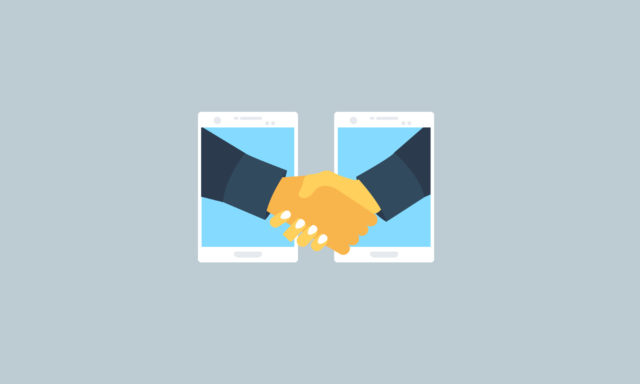Table of contents
The handoff of qualified leads from marketing to sales is notoriously tricky.
On one hand, if a marketer delivers a high volume of low quality leads, their sales team will lose patience after spending hours on the phone with the wrong prospects.
On the other hand, if a marketer puts all their leads through lead nurturing campaigns before handing them off to sales, their company can miss a window when prospects are ready for a sales call and potentially lose a deal to a competitor who strikes faster.
And that’s just one thing marketing and sales teams have to get right in order to turn leads into sales.
To provide the best possible guidance for turning leads into sales at the highest rate possible, we polled our community of digital marketers to uncover the tools and tactics they use to maximize this conversion rate.
The tips include topics as broad as website design, downloadable content, sales and marketing emails, and of course, old-fashioned sales outreach.
Lead Conversion Tactics

Bottom of Funnel Content
When a prospect downloads and reads a piece of content, they still may not be interested in doing a sales call. They may be exploring the general topic, and might not be convinced that they need what you offer.
Bottom of funnel content helps you address common concerns from prospects, and gives them a chance to investigate on their own without committing to a high-pressure sales call.
 Natalie Marovich
Natalie Marovich
Revenue River
Tactic: Adding a second conversion point to thank-you pages and landing pages. It is important to encourage individuals to move down the funnel until they have the resources and knowledge they need to convert.
For example, offer another piece of content to contacts who have downloaded an eBook or include a CTA that encourages contacts to subscribe to your blog.
 Adam Rowles
Adam Rowles
Inbound Marketing Agency
Tactic: A typical website will convert 2.35% on average across most industries, so I cannot emphasize the importance of improving conversion rate from visitor to lead enough.
Creating educational content packaged into an ebook that is promoted on a landing page can improve conversion rates by up to 638% from previous experience.
I know it’s common sense from a marketing point of view. However, we do not see it executed too often, probably due to the resources and time required to complete.
We have found in the right scenario conversion rates can go from 2.35% to ~15% with this approach.
Often this approach works well when people are in the awareness and consideration stage of the marketing funnel.
For example, when someone has many questions about the solution offered.
Offering an educational resource such as “Search Engine Optimisation Buying Guide”, provides the ability to demonstrate expertise and build trust too.
It’s worth noting you’ll need to nurture these prospects more than if they came through your contact/enquiry form, as they aren’t ready to buy. However, you can use marketing automation software to nurture them without the additional resources.

 Jennifer Schulman
Jennifer Schulman
Fortune Web Marketing
Tactic: Adopt a true inbound marketing strategy. By doing so, you will need to create content that caters to the buyer during their stage of the sales cycle.
Content they need at this stage.
Content they will interact with.
It takes time to develop a Buyers Journey and create content ideas around this strategy, but it is well worth it. Generic messages and content that is not valuable will not work for people further along in the sales cycle. Try providing them with infographics, case studies, whitepapers, etc…during this stage.
 Chris Handy
Chris Handy
ClosedWon
Tactic: Several years ago, when we were just getting started in aggressive content marketing, we started generating a lot of interest in our content, and a lot of top of the funnel leads.
I would often get inquiries that turned out to be “pick my brain” conversations based on something I wrote that resonated with people. I had dinner with Nick Salvatoriello (who at the time was at HubSpot) one night and a conversation we had over a few Imperial IPAs changed my outlook on how to address these leads, and what to do in the middle of the funnel.
Nick had led a broadcast for the Partner Program at HubSpot. We talked about how this was a central hub for the community at the time. When people had a question, you could point them there. That is when we started doing Live AMA Webinars in 2014.This turned out to be an amazing middle of the funnel strategy and an easy and non-salesy way to reach out to people who had just converted on what in hindsight might have been a flimsy e-book.
I was amazed at the response. We’d have 5, then 10, then 20, then up to 50 people on the regular webinars and I was just getting started. I can book hundred of thousands in revenue (we are a small shop too) back to these campaigns. We had the added bonus of being able to filter all the pick my brain requests to the “Inbound Success Workshop”, which is what it came to be called. Here’s an example of an episode. This one featured Sarah Bedrick, who also got in on the Q&A game. Leveraging friends in the industry to help do these AMA’s was a big part of the growth.
This technique is what led us directly into podcasting with “HubSpot To Go” (which was basically a bite-sized way of delivering answers to clients, but also to the world), and the “Pick Our Brains” show that Don Stanley & I did together throughout the lifetime of the now-defunct Blab video social platform.
We are getting ready to relaunch a version of this video Educational/AMA hybrid in Facebook Live format in our Roundtable for Drift Users Facebook Group.

Buyer Personas
If your pipeline is full of the wrong type of leads… well, no amount of clever tactics will be able to help! Sometimes, you need to look further upstream in your funnel, and consider whether your content is really attracting the right type of prospect.
This can also impact your tactics at the middle and bottom of funnel. For example, after examining your leads, you might discover that your leads are usually director or manager level, but you know you need to reach VPs to close a sale and therefore, you need a new set of marketing and sales tactics to help your salesperson get to the VP.
 Brittany Laeger
Brittany Laeger
StoryTeller Media + Communications
Tactic: One of the biggest things we’ve done to help clients increase their lead to customer rate is helping them map out their sales journey.
Fully answering the question “what happens after this lead converts?” is not something that a lot of businesses take the time to figure out.
There are often many gaps in the process and places where really good, warm leads fall off the radar of the sales team. By having a really solid sales plan and mapping content to each phase of that plan, you can really increase your closing rate.
 Dennis Seymour
Dennis Seymour
LeapFroggr
Tactic: I use personalization. By understanding your target, you can craft messages that they can relate to. You put those on a landing page, create an ad also with those messages and customize the funnel just for them. I’ve seen an over 50% increase in conversions.
Of course, awesome customer service that lets them feel that you are all-in helps a ton with the first impression. It’s why I integrate live chat, FB messenger and instant phone callings via the website (using Callpage). Get that first conversation ASAP and make sure to leave a great impression on the first conversation.
 Deepa Venkataraman
Deepa Venkataraman
Vajra Global Consulting Services LLP
Tactic: When we started out, we got busy talking to a lot of people who we would consider as prospects. A lot of time, effort and money were invested in convincing the wrong set of people for our services.
We then realized that we had to improve the quality of prospective leads and spend our resources more wisely. From then on, our marketing team has been channelizing all efforts into identifying and capturing more qualified leads for our business and translating them into customers. This has been a significant learning in our journey and we plan to get better with time.
It is essential to track the success of your marketing campaigns, especially, when it comes to conversions. Lowering your cost per lead/ cost per conversion is an extremely vital factor for your business. To do that, start right at the beginning. Filter your visitors into high quality leads to achieve higher success rate. This has worked really well for us and we believe it will work for anyone who is able to get the crux of this.
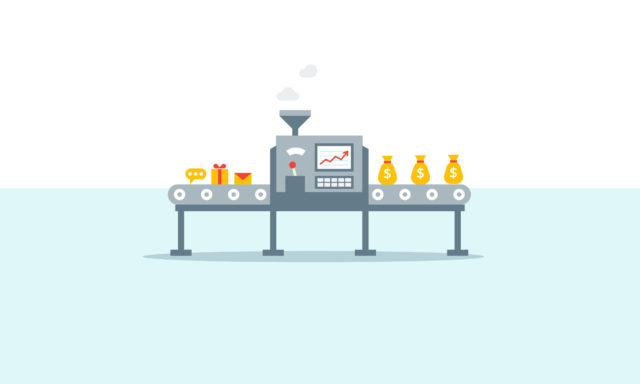
Conversion Optimization
Let’s say that a prospect has subscribed to your email list, read a few blog posts and read one of your top-of-funnel ebooks as well.
But in order to book more calls for your salespeople, you need to use the right content, calls-to-action and offers to compel the prospect to raise their hand. The following tips will help you think through that process…
 Juli Durante
Juli Durante
SmartBug Media
Tactic: Increasing conversion rate with an applicable pop-up is a best bet.
By “applicable” I mean:
- Using the right message
- Not obnoxious
- Easy to close
- Behaviorally-triggered (click element (e.g. demo request on a pricing page), exit-intent, etc.)
These popups should have the form within them and not ask the user to go to another website page to convert. Here’s the logic with some nice round numbers (and the results I’ve seen for a variety of clients in different industries and contexts)
– You might expect a prominent CTA button on a website page to have a 5% click-through rate to a landing page, then the landing page to have a 40% submission rate.
– If your page gets 1,000 views, that means 50 people click the CTA, then 40% of them, or 20 people, ultimately submit the form.
– With a popup form, I’ve seen submission rates at the same performance as traditional CTA click-through rates and higher than landing page submission rates. You’re working towards eliminating the 60% drop off of the high performing landing page above.
Now, that’s hypothetical, but here’s some real data.
We used Sumo to optimize some key pages of a SaaS website with tremendous results. This client averaged about a 7% submission rate on their demo request landing pages. With Sumo, we set up a CTA to trigger a pop-up form on the pricing page. When the CTA was clicked, instead of being taken to the landing page where 93% of users would drop off, they saw a simple pop up form for requesting a demo – and 36% of those who clicked the button actually submitted the form – over a 410% improvement in submission rate for the client’s bottom of the funnel goal conversion.
When we think about inbound and the buyer’s journey, this makes a lot of sense. We know a few things:
- A buyer who views the pricing page is much further in their journey than someone who reads a few blogs
- Someone who clicks a request a demo button is more likely to…actually request a demo
- The extra steps and barriers of landing pages almost always result in more people not taking action than taking action
Popup forms are all about reducing friction to improve conversions, with the right offer at the right time for the right buyer.
Of course, these pop-up forms and CTAs are by no means a panacea. You can’t put them on every page of your website and expect stellar performance. They need to be strategically applied and measured, and accompanied by other CRO strategies: If a pop-up form increases submissions, that’s great… but not if no one clicks on that CTA to begin with.
 Eric Quanstrom
Eric Quanstrom
CIENCE Technologies
Tactic: One tip is to spend time thinking about the Call-to-Action for any communication. Whether a form fill on a Website or the request for a meeting in an email outreach, the Call-to-Action should always be crystal clear. It should always be singular. It should be easily understood and natural for the lead to convert (e.g. low friction).
When the reverse is true, conversion rates drop. Want to make any marketing communication less effective? Add options and a muddled message of what it is you actually want a prospect to do.
This “gateway” in any sales cycle is heavily underappreciated because the lead that never converts at this stage is never counted in most funnel metrics. Don’t let a poorly thought out Call-to-Action sub-optimize your go-to-market.
 Tyler Pigott
Tyler Pigott
Lone Fir Creative
Tactic: We’ve started to implement “lead flows” (Hubspot term) also called pop-up boxes, drop down or slide in…for both our customers and our own website. They’ve worked really well! Customize with images and easy forms to fill out.
There are lots of ways to make them appealing to your audiences. The key is to know when and where it’s appropriate to use a lead flow on your website. Serve up the right information on the right pages so that it is applicable to users on your site and the information they are looking for.
 Kevin Williams
Kevin Williams
SurgeStream
Tactic: We’ve employed a time-sensitive call-to-action with multiple clients to increase their conversion rate. These CTAs, when employed truthfully and carefully can create a sense of urgency that many website visitors will find difficult to ignore and entice them to either signup for a free trial, a consultation or purchase something as a special sale offer.
There are many ways to implement time-sensitive offers and it really depends on the niche or category the website falls under. For example, you don’t want to offer a limited time free trial on a drop shipping e-commerce site, but a sale that ends on an upcoming date makes perfect sense.
When setting up these offers, you will definitely want to split test the heck out of them! Don’t assume one offer will work better than another offer. And don’t just copy what your competitors are doing either. What might work for them might not work for you, or perhaps your offer can outperform theirs. You really need to test everything thoroughly and scientifically to ensure that you obtain the best ROI.

Email Nurturing
In an ideal world, your prospects get onto calls with salespeople and already know your value proposition. To do that, you need a way to get targeted information to the right prospects so that the sales team does not need to explain the basics. Email nurturing in the middle and bottom of the funnel ensures that prospects will be informed before ever talking to your sales rep. It also increases the chances that they’ll want to talk to your sales rep!
 Kelley Wrede
Kelley Wrede
Revenue River
Tactic: The biggest game changer for us and our clients in regards to increasing lead-to-customer conversion rates has definitely been treating sales the same way that we treat marketing. We inject the same proven automation and nurturing into the sales funnel that we do in the marketing funnel.
Often, marketing gets all the cool stuff and sales is left in the stone age – how is sales supposed to convert SQLs into customers once they get handed off at such a disadvantage? It benefits everyone to apply the same principles and practices that worked for marketing to attract and nurture the qualified lead in the first place to then nurture and close that same lead into a customer for sales.
Basically, once that lead crosses over into the SQL threshold, they need to start over in a new buyer’s journey between the SQL and Customer stages where they need to be educated and nurtured again until they are closed/won.
To achieve this, build collateral specifically meant for the sales team to use in their own education and nurturing process and build automated sequences they can use throughout the sales cycle for more efficiency. Enable them with tools that will make their jobs easier and give them more visibility into the lead’s history with marketing so they have more context and know exactly how to approach that particular lead in each deal stage.
In the end, it was us all realizing we wouldn’t see customer conversion rates grow until marketing stopped removing ourselves at the SQL stage and saying “we’ve done our job, it’s your turn” and instead partnered with the sales team and let them in on some of our tried and true marketing secrets to see the lead all the way through the process.
Track all your email marketing metrics in HubSpot with the Email Campaigns dashboard
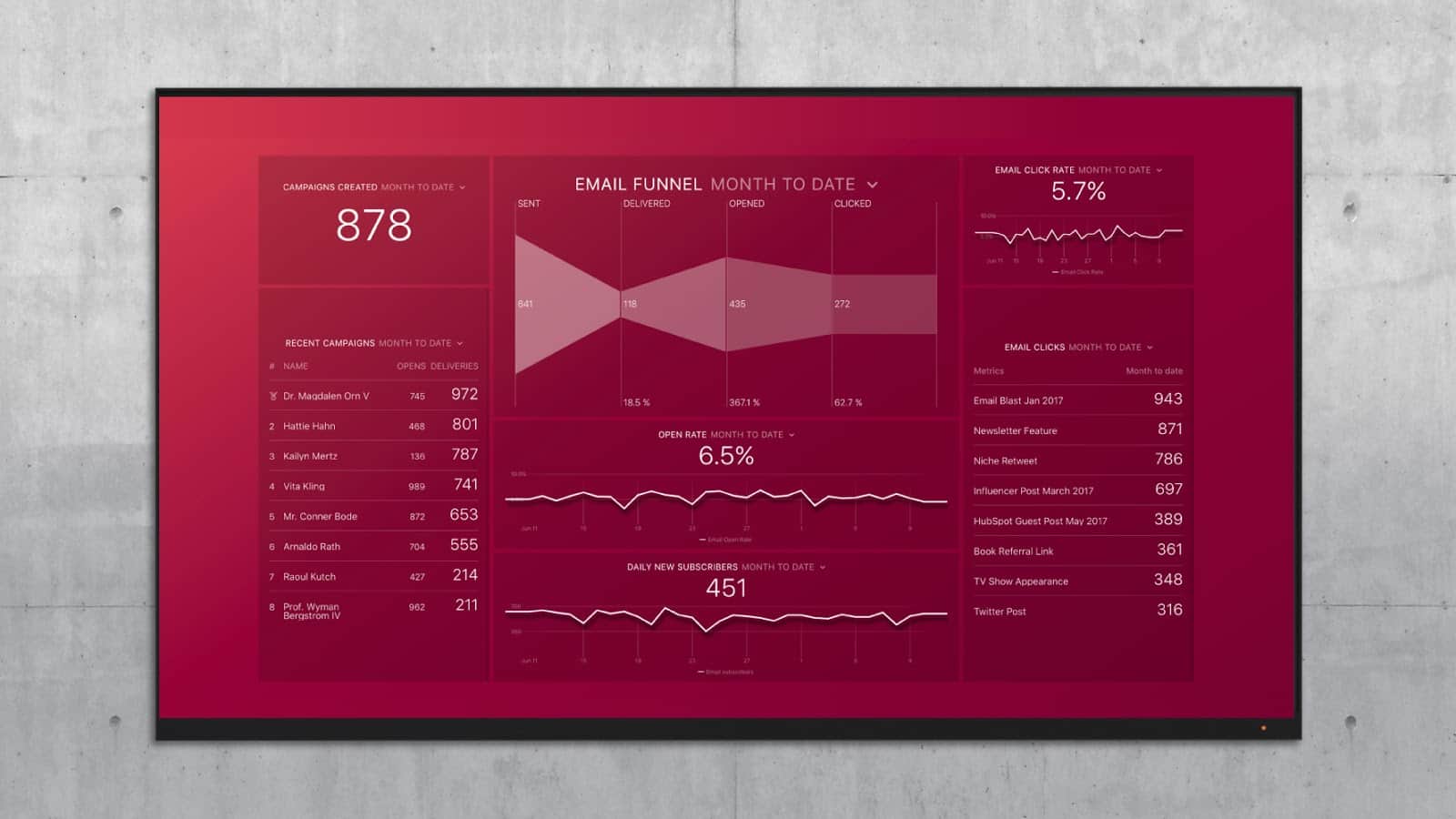
 Lorraine Reguly
Lorraine Reguly
Wording Well
Tactic: Give people content upgrades and get them on a specialized email list. You will then know what kind of information they need, and you will be able to better serve them.
For example, because I am an editor (among many other things!), I gave people 17 additional tips in my blog post that offered 5 editing tips (found here).
By doing this, I’m encouraging them to take their writing seriously and offering them FREE ways for them to do it on their own. At the same time, I’m showcasing my own talents and skills.
Most people eventually get tired of trying to make their writing perfect on their own and come to realize that it’s easier to pay a professional to polish their words for them.
That’s where the sales come in!
 Darrell Evans
Darrell Evans
Yokel Local Internet Marketing
Tactic: Too many of us get excited to talk about lead generation funnels. We make the mistake of lumping too many of our prospects into the SAME buyer’s journey.
To increase your lead to customer conversion rate, the first step is to narrow the funnel through which the prospect can become a lead.
We’re a huge fan of using targeted pop-up opt-in forms to generate narrowly focused leads on our client’s websites. After we get our clients to get over their personal preferences of how they view pop-ups as annoying, we show them the data and they can’t believe it.
We then deploy laser focused pop-ups to bring only those visitors who are highly-qualified prospects into the funnel on the website. We may use one or five on a website depending on how many buyer personas we are attracting to the website.

The #1 strategy we use to increase lead to customer conversion rates is empathy based email nurturing sequences.
Just because they may be the right lead doesn’t mean they are ready to buy today.
So we build empathy-based email sequences around each individual buyer persona for as long as the buying cycle might be, which means we aren’t lazy.
Yes, it takes more time. Yes, it costs more money. Yes, it’s worth it because the sales team can then focus on the leads that are at the bottom of the funnel ready to transact.
When you spend the time to understand the needs of each of your buyer personas, narrow the lead generation funnel that they walk through to get to you, build out the email sequences that speaks to their needs, emotions, concerns and fears, conversion rates must increase.
It’s just a matter of time and whether or not you’ll be top of mind when they are ready.

So narrow your lead generation funnel and deploy empathy-based email nurturing sequences and watch your lead to customer conversion rate grow.
 Andrew Chao Daongam
Andrew Chao Daongam
Bethink Marketing
Tactic: For a client in the finance sector, we indicated prospects and validated the leads by letting them know that the company works with a specific type of clientele.
First, in the forms, we left a note as to who the company can best serve. Second, we double qualified them throughout the lead nurturing process. The initial BOFU form gives us an idea if they are a good fit but before sales reaches out to them, an email is sent out to ask them to fill out a qualification form.
But of course we don’t call it that. We tell prospects, that in order to have a fruitful conversation for them, we would like to ask additional questions. The form only consisted of 3-4 dropdown select questions.
Sales Tactics
While most businesses can benefit from a smart marketing automation strategy, if someone has indicated interest in your products, it’s best for your sales team to connect and figure out how you can help them.
A sales call at the right time gives your sales rep a chance to position you and themselves as an expert in the particular problem that the customer is trying to solve.
Many of our experts recommended a more aggressive and personalized follow-up approach than any marketing tool makes possible…
 Mike Schiemer
Mike Schiemer
Bootstrap Business
Tactic: When I get inquiries about consulting and marketing services, I like to respond with a personal and detailed note.
Even if it’s early in the game, I’ll take a look at their website, social media, SEO strategy and provide them up front with some specific insights and areas I can assist them with. This shows them that I actually took the time to assess their specific business needs (surprisingly rare these days) and also that I know what I’m talking about. It’s an automatic boost in legitimacy. Often times, leads are then ready for a phone call or face-to-face meeting to convert them into clients. After the deal is closed, then hopefully they also become a source of testimonials and referrals to help continue the sales cycle!
 Richard Owens
Richard Owens
First Five Eight Media
Tactic: Follow Up – it’s that simple
Previously there was a rule that you needed 7 touch points before closing a client. With social media and online marketing, this can now incorporate multiple impressions between touch points. But you will need to email, phone, direct mail, message, and meet in person to close a client. Most salespeople quit after the second touch point.
 Thorstein Nordby
Thorstein Nordby
Nettly
Tactic: Use a solution like Vidyard’s GoVideo! or Wistia’s Soapbox to send a personalized 45-60 second video to a prospect who just converted on your website. This is a great way to get on prospect’s radar and start building that relationship with a potential client. These solutions also measure opens and view time, making your outreach very measurable.
I usually send interesting prospects a quick video introducing myself and give a few quick tips on how to improve their inbound marketing efforts. I then attach a relevant article for their specific situation and ask them in the video what they’re looking for help with.
It is personal, easy to do and I have only gotten positive feedback on it.
 Evan Ebert
Evan Ebert
Fannit Marketing Services
Tactic: Above all else, no matter how cool your product/platform/process is, make sure that you keep the focus on the client and their needs.
MAKE SURE THAT YOU KEEP THE FOCUS ON THE CLIENT AND THEIR NEEDS. No, really. I needed to say that twice and in all caps.
This is something that it seems like every sales rep or account manager claims to objectively understand, such as “I know I should eat less and move more.” But do they all do it? Well…
So let me give you an example of what happens when you don’t do this. My team and I had an opportunity about 1.5 years ago with a pretty slick cloud document storage company. The “lead” was the marketing manager for the company, and he was pretty much on his own to do most of the activities as they were in a big growth phase.
We went through our sales process together, collecting some information about his existing marketing performance and spinning up a service package that we figured was going to do the trick.
But he never showed up to the “close call.” We emailed for a couple days afterward, and we never got a reply.
Until a week later, he hops on a call with us.
Candidly, he explains that while we seemed very professional and he was impressed with our team’s capabilities, he did not get the sense that we really took the time to get to know his unique situation and the company’s real needs. We just knee-jerk reacted to some key things he said in our original conversation and spit out a solution we thought was viable.
It was embarrassing, humbling, and cathartic, all wrapped into one neat package.
Not every prospect, lead, or even client is going to be cool enough to actually tell you why you screwed up. This guy was no bulls*** and we really appreciated that.
It’s always been paramount to me from that point onward; no matter how well you think you understand your lead’s needs, keep asking them questions. Get them to engage and get them to tell you more.
 Andy Hoek
Andy Hoek
Invalshoek
Tactic: Just give your leads a phone call! I’m surprised how often companies want to be pure digital players, but really you should just give them a call to offer your help. Use a form to collect phone numbers or search for the number on Google after you’ve nurtured them with email marketing. Also, you should always have a call-me-back form on your website.
 Michael Rand
Michael Rand
Market Veep
Tactic: Nothing beats rapid follow-up.
Not long ago, we saw a huge increase in organic traffic and lead conversions on our website, and they weren’t just marketing qualified leads downloading our content. People were filling out our direct contact form and asking for a free marketing assessment.
We set up our direct contact form so that our lead salesperson received an immediate notification if anyone filled it out. She responded almost as rapidly to most of the inquiries. She has a pretty excellent close rate, so we saw several leads become customers in just a couple of months.
When you’re doing digital marketing, it’s easy to forget that your “leads” are human beings. They may have immediate needs. Many of them may be ready to talk to a salesperson after just a few minutes on your website. Create a dedicated form on your website for those people.
When they fill it out, call them within 24 hours (or the next business day if it’s the weekend). The sooner you get them on the phone, the sooner you can start working your sales magic. If they aren’t ready to buy, that’s okay. You can nurture them and follow up later.
 Ryan Howard
Ryan Howard
HeadsUp Marketing
Tactic: Ask better questions.
Instead of trying to push your products or services on them, you can greatly improve your conversion rate by asking questions that truly get to your customer’s pain points and then by positioning yourself as an authority on the subject.
 Joe Jerome
Joe Jerome
Brand Builder Solutions
Tactic: You increase the lead to customer conversion rate by making a sale. Defining a lead could be the hardest thing for an organization to get straight. Often you will see companies call a person who downloaded an ebook a lead. In large sales organizations, the leads are categorized as a marketing qualified lead, MQL, or a sales qualified lead SQL.
Many companies begin to create a process around the qualification of leads. This can often become more of a technical endeavor or marketing-driven process.
Most organizations lack a sales expert and employ systems first without a focus on having a well-coached sales team. I have had personal success hiring a sales coach. Hiring a sales coach was the best investment I’ve made in my company. A great sales coach will train you how to be a sales leader and a coach within your team for sales as well.
Power tip: Be willing to invest in the right person. If you see a rockstar salesperson at an organization, ask them how they did so well. Ask them who taught them.
 Alex Swallow
Alex Swallow
The Influence Expert
Tactic: One of my most successful tactics is following up with people after we link on LinkedIn. For this to work best, three stages are needed. First, you need to have a good LinkedIn profile and to reach out to your audience effectively on the platform.
Second, you need to make sure that you are building up your network. Especially at first, this may involve you sending link requests but over time if you use the platform properly you will have lots of interesting people approaching you. What criteria you use for deciding whether to accept requests is up to you.
Third, you need to begin a conversation. I suggest that initially you send them something that serves as an introduction to your work, perhaps a recent article that you think they might find interesting. A mistake that I see people making on LinkedIn is linking and then immediately sending a sales message. You need to find a more gradual way to build up trust with your new connection.
Used this way, LinkedIn can lead to more clients, more opportunities and a more engaged, mutually-supportive network.
Track Lead Conversion KPIs in Real-Time
The tips above cover both the sales and marketing teams. Depending on your customer’s buyers journey and marketing tactics, you may need to track KPIs using lead generation dashboards– like your lead to customer conversion rate — in order to monitor and improve performance.
If you use HubSpot Marketing and CRM, you can use the Pipeline Performance dashboard to track your full funnel all in one place.
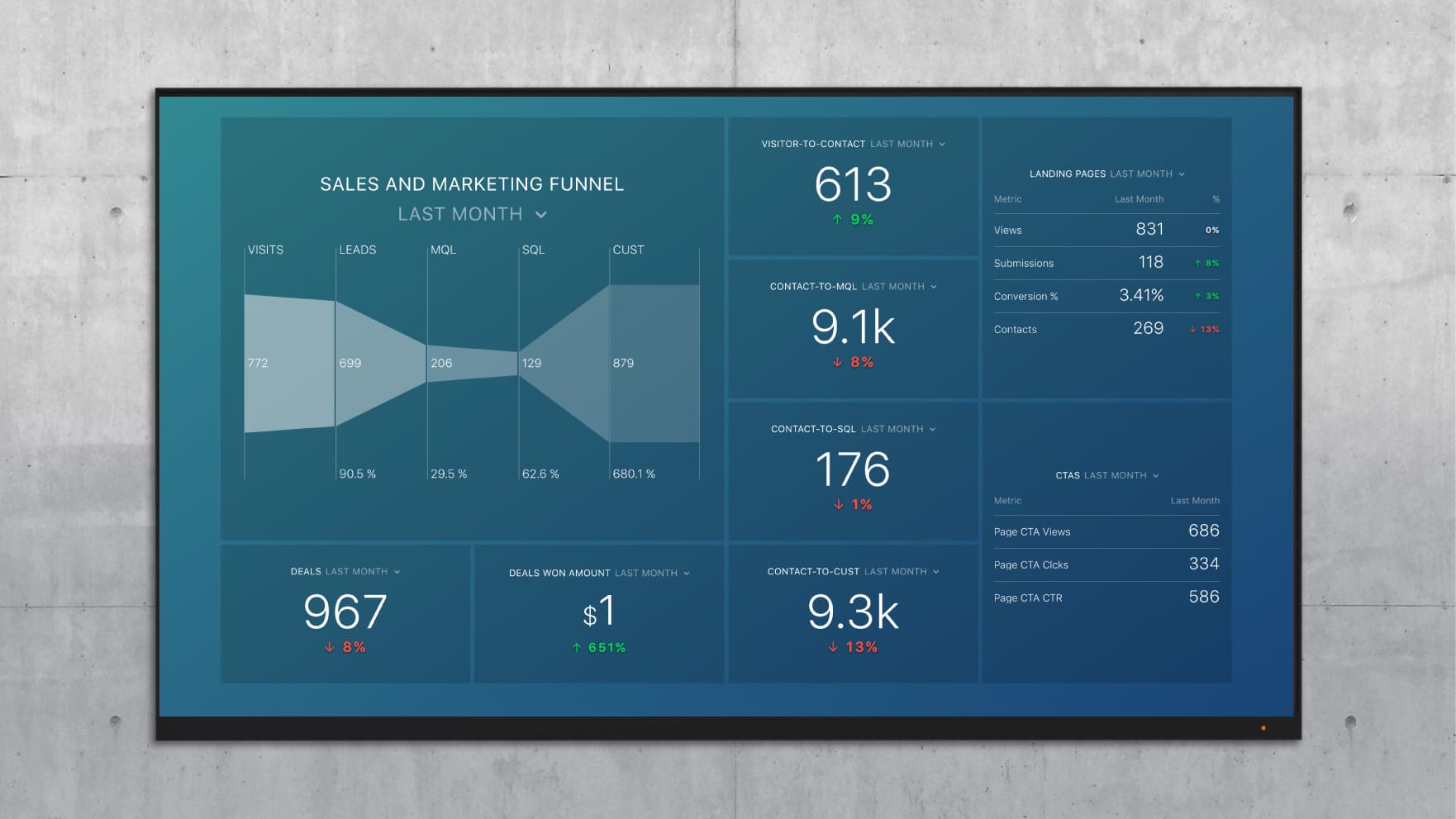
If you use Salesforce, you can use the Salesforce Leads dashboard to track the newest leads that may need a call from a member of the sales team.
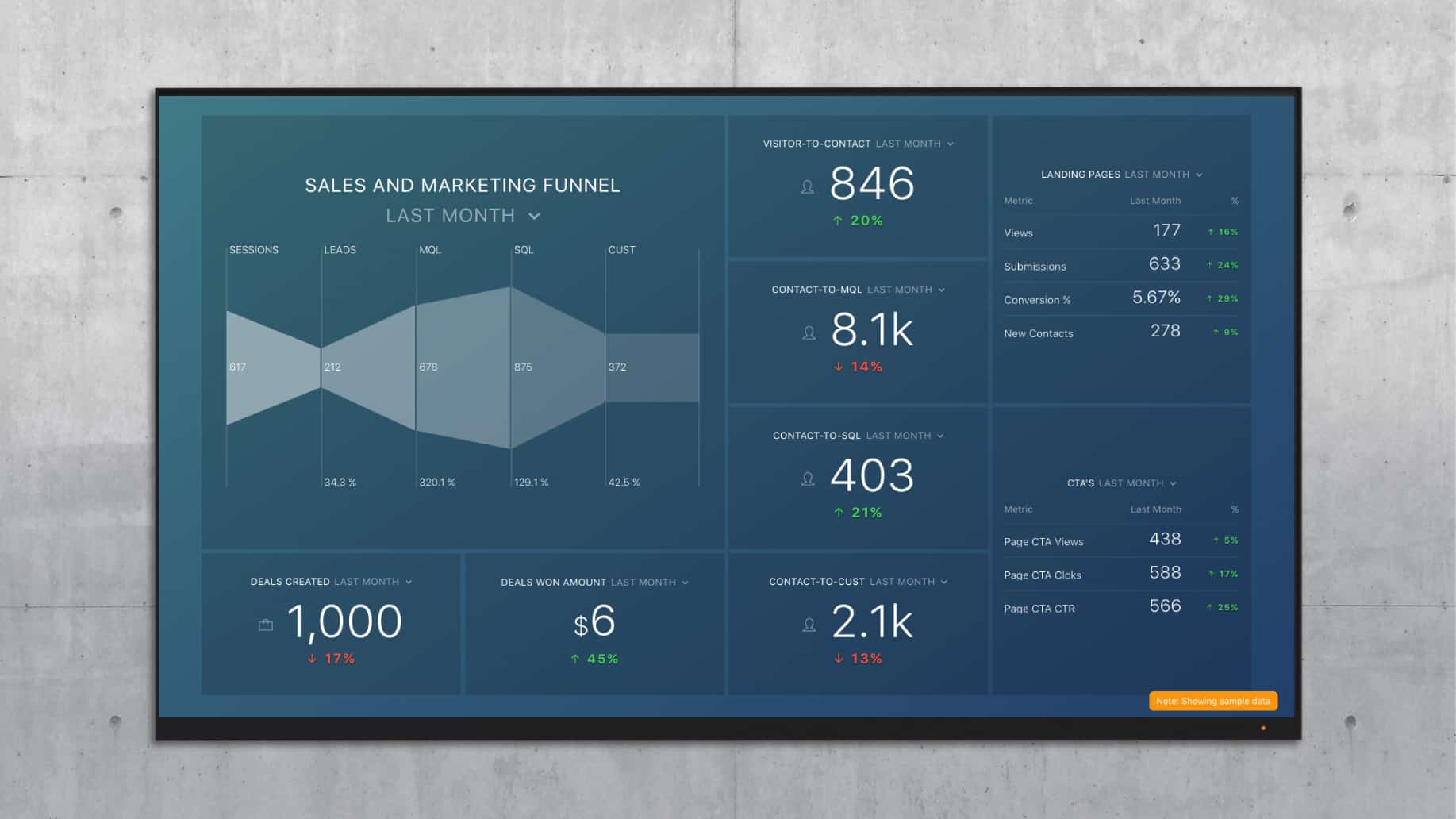
Or, if you use another CRM like ActiveCampaign, Pipedrive or Prosperworks, check out Databox’s Template Library to grab a free template to instantly track your numbers.
PS. If you want to learn how to turn more of your website visitors into leads, check out our guide to lead capture here.





